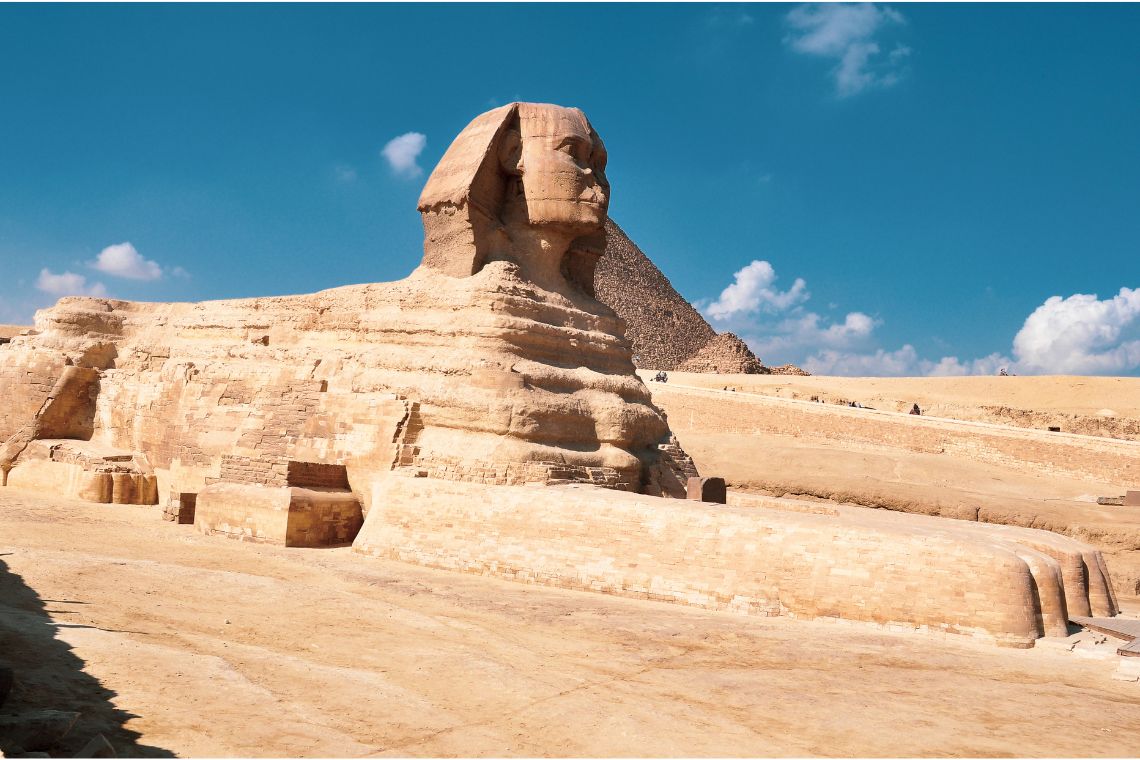The Sphinx, a legendary creature combining human and animal traits, holds a unique place in the mythologies of Ancient Egypt and Greece. While it shares a common form in both cultures, its roles, meanings, and symbolism differ profoundly. This duality reflects the distinct philosophies and artistic traditions of these civilizations.
Table of Contents
ToggleThe Egyptian Sphinx: Protector of Divine Order
In Ancient Egypt, the Sphinx epitomized protection, divine authority, and strength. Often depicted as a lion with a human head—typically that of a pharaoh—the Sphinx represented the union of animal power and human intellect.
![]()
The Great Sphinx of Giza
The most famous example, the Great Sphinx of Giza, stands as a monumental testament to Egypt’s devotion to divine kingship. Carved during the reign of Pharaoh Khafre around 2500 BCE, this limestone colossus guards the pyramids of Giza, symbolizing the pharaoh’s eternal watch over his realm and the gods’ protection over the land. Its placement facing the rising sun aligns with the Egyptian reverence for Ra, the sun god, further emphasizing its role as a divine guardian.
Guardians of Sacred Spaces
Beyond Giza, smaller sphinxes were commonly placed at temple entrances. These statues functioned as protectors of sacred spaces, warding off chaos and ensuring the sanctity of the gods’ domains. The Egyptian Sphinx was not a creature of riddles but of silent vigilance, embodying stability, wisdom, and the eternal connection between rulers and the divine.

The Greek Sphinx: The Enigma of Intellect and Peril
In contrast to its Egyptian counterpart, the Greek Sphinx was a creature of mystery, danger, and intellect. With the body of a lion, the wings of an eagle, and the head of a woman, the Greek Sphinx embodied a more sinister and enigmatic character.
The Myth of Oedipus
The Greek Sphinx is best known from the myth of Oedipus. Perched near the city of Thebes, she posed a riddle to travelers:
“What walks on four legs in the morning, two legs at noon, and three legs in the evening?”
Those who failed to answer were devoured. The Sphinx’s riddle symbolized the human quest for knowledge and the consequences of ignorance. When Oedipus correctly answered “a human being,” the Sphinx destroyed herself, marking the triumph of intellect over mystery. Yet, her presence in the myth also foreshadowed tragedy, aligning her with the inescapable fate central to Greek storytelling.
Symbol of Intellectual Challenge
Unlike the Egyptian Sphinx, which symbolized protection and order, the Greek Sphinx represented intellectual challenge and mortal vulnerability. She was a creature of chaos, testing human wisdom and exposing frailty. Her dual nature as both an adversary and a bearer of profound truths reinforced the Greek fascination with the tension between knowledge and destiny.

Contrasting Roles, Shared Legacy
The stark contrast between the Egyptian and Greek Sphinxes reflects the differing worldviews of their creators.
- In Egypt, the Sphinx embodied stability, divine protection, and cosmic order.
- In Greece, it symbolized the enigmatic, dangerous pursuit of knowledge and the fragility of human existence.
Yet, both interpretations share a common thread: the Sphinx as a symbol of humanity’s attempt to grapple with the unknown. Whether as a steadfast guardian or a deadly challenger, the Sphinx inspired awe and curiosity, bridging the gap between mortal understanding and the mysteries of the universe.
The Timeless Symbol of the Sphinx
Through its depictions in art, architecture, and mythology, the Sphinx has endured as a powerful cultural symbol. Its duality—embodying both protection and peril—continues to fascinate, serving as a reminder of the human quest to explore, understand, and conquer the unknown. From the sands of Giza to the cliffs of Thebes, the Sphinx stands as a timeless icon of power and mystery.
